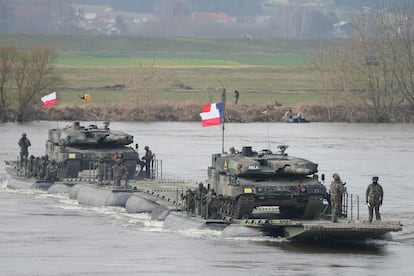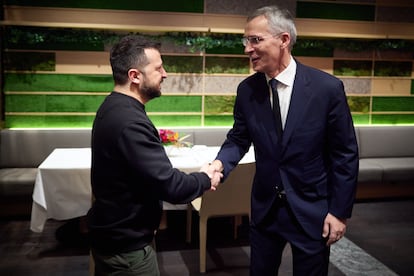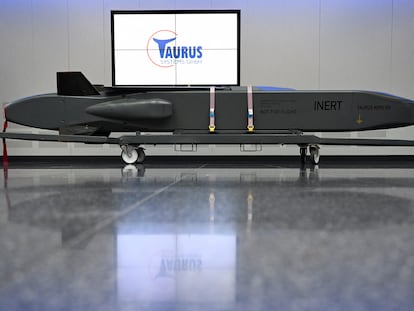NATO personnel already in Ukraine for arms control, intelligence operations and military training
The French proposal not to rule out sending soldiers to fight against Russia opened a debate that confirms there are soldiers from the Atlantic Alliance on the ground, but not in combat roles

Emmanuel Macron broke the taboo in February. NATO already assists Ukraine in virtually every possible aspect, from supplying weaponry and intelligence on Russian targets and the positions of enemy bombers to training thousands of Ukrainian troops in Europe. But until the French president suggested it, no one had dared to raise the question of Atlantic Alliance soldiers going into action to stop the Kremlin’s invasion. Macron not only opened a debate; his words also served to confirm that there are already military personnel from NATO countries on Ukrainian soil, albeit without taking an active role in combat operations.
Polish Foreign Minister Radoslaw Sikorski told a conference in Warsaw on March 8 that there were already representatives of the Atlantic Alliance in Ukraine. “NATO soldiers are already present in Ukraine. And I would like to thank the ambassadors of those countries who have taken that risk. These countries know who they are, but I can’t disclose them. Contrary to other politicians, I will not list those countries,” Sikorski said. The last sentence was a veiled criticism of German Chancellor Olaf Scholz, who in late February revealed that British and French military personnel are in Ukraine. Scholz argued that his government would not provide Kyiv with its Taurus long-range missiles because it would require — as has happened with the British-French Storm Shadow / Scalp rockets — sending military technicians for the programming of these weapons.
The presence of soldiers from NATO countries in Ukraine is nothing new. Pentagon spokesman General Pat Ryder confirmed in October 2022 that the United States had military representatives stationed to perform the task of monitoring the supply of armaments. In confidential Pentagon documents leaked in April 2023, the U.S. Defense Department indicated that five Atlantic Alliance countries — the United States, France, the United Kingdom, Lithuania, and the Netherlands — had around 100 special forces personnel at their embassies in Ukraine.
The Czech president, Petr Pavel, a retired general and former chairman of the NATO military committee, recalled on March 10 in a television interview that Atlantic Alliance soldiers have been present in Ukraine for over a decade, not in combat units but as instructors for the Ukrainian army. Pavel was referring to the Yavoriv base, near the border with Poland, where an agreement between NATO and Kyiv has allowed 1,000 soldiers from 15 countries to pass through, according to Pavel. The Czech president stressed that military training programs on Ukrainian soil were active when Russia annexed Crimea in 2014 and during the Donbas war, initiated by pro-Russian separatists and supported by Moscow. The Yavoriv base was shelled in March 2022. Ukrainian authorities indicated that 61 servicemen lost their lives, while Russia raised the number to 180, claiming many of them were foreign soldiers.

Informants on the ground
During the more than two years of the war EL PAÍS has interviewed multiple military sources, both Ukrainian and from EU countries, who agree that no NATO member army has participated in ground combat actions. But they also agree that they do have informants on the ground to provide knowledge about the situation on the front, to identify the effectiveness of the weapons supplied and possible problems in their use, as well as to detect possible cases of corruption concerning the aid provided. Part of these unofficial informants are retired foreign military personnel fighting as volunteers in the ranks of the Armed Forces of Ukraine. At least two sources, one American and one Ukrainian, claim that Washington is particularly active in monitoring their assistance, with missions arranged between its Embassy and the Ukrainian authorities, but also in inspections outside institutional channels.
Luke Coffey, a research fellow at the Hudson Institute, a U.S. center for international and defense policy analysis, finds it difficult to believe that U.S. military personnel could be moving freely around Ukraine: “I would be very surprised if U.S. troops have freedom of movement to move around the country to monitor the situation. I know that U.S. Embassy personnel even need a permit to go to Odesa. And before 2022, U.S. instructors were not allowed to go east of the Dnipro River. I doubt they can now.”
Olga Husieva, a researcher at Kiel University’s Institute for Security Policy, differs from Coffey and takes it for granted that there are envoys from Ukraine’s allied defense ministries collecting data on the ground. In her understanding, these may obtain fundamental knowledge to improve the readiness of their own armies and the use of their weaponry; they may also be tasked with ensuring that there are no weapons ending up on the black market, as happened after the 2021 withdrawal from Afghanistan of the U.S.-led Western coalition. “It is also no secret that there have been instructors in the country since the beginning of the invasion,” she adds.
Husieva stresses that, above all, these are individual initiatives of the governments in question, although she emphasizes that there is coordination between the United States and the United Kingdom, and, although to a lesser extent, from Washington and London with Poland and the Baltic countries. This expert warns that Germany is being excluded from this cooperation for fear of the infiltration of Russian spies in its intelligence services. Lukasz Maslanka, a researcher at the Polish Center for Eastern Studies, is also of the opinion that “there is probably coordination and mutual transmission of information, but each country makes its own decisions.”
Coffey concedes: “Perhaps there are limited, technical reasons for NATO personnel on Ukrainian territory, but it should be avoided. It would be better to replace them with civilian professionals.” Husieva notes that the Storm Shadow missile case cannot be unique, and assumes that NATO instructors will be deployed to Ukraine when the first U.S. F-16 fighters arrive later this year. Also, she points out, collaboration will increase with the use of artificial intelligence to coordinate attacks. In her opinion, in addition to the possible presence of engineers to monitor the entry into service of advanced weaponry, it is always necessary for military personnel to be present. The Ukrainian president himself, Volodymyr Zelenskiy, gave as an example on March 11 in Le Monde the possibility of French Caesar howitzers and German Leopard tanks being repaired and produced in Ukraine, with inevitable military assistance on the ground.
Maslanka agrees with Husieva that the call by political leaders such as Macron for the involvement of NATO soldiers in Ukraine is primarily a strategy not to be cowed by Russian President Vladimir Putin: “It’s about provoking a dilemma for Putin and adding a new risk factor for him.” Husieva adds that she sees it as “quite possible” that a coalition of countries consisting of the United Kingdom, Poland, and the Baltic states will reach an agreement in the future to be in Ukraine. Coffey, on the other hand, believes that it would be a serious mistake in the face of Republican unblocking of U.S. military aid: “There are many Republicans worried that the U.S. will enter a new eternal war. Supporters of Ukraine argue that won’t be the case because there are no American troops fighting, and Macron counterproductively suggests that NATO troops could be deployed.”
Sign up for our weekly newsletter to get more English-language news coverage from EL PAÍS USA Edition
Tu suscripción se está usando en otro dispositivo
¿Quieres añadir otro usuario a tu suscripción?
Si continúas leyendo en este dispositivo, no se podrá leer en el otro.
FlechaTu suscripción se está usando en otro dispositivo y solo puedes acceder a EL PAÍS desde un dispositivo a la vez.
Si quieres compartir tu cuenta, cambia tu suscripción a la modalidad Premium, así podrás añadir otro usuario. Cada uno accederá con su propia cuenta de email, lo que os permitirá personalizar vuestra experiencia en EL PAÍS.
¿Tienes una suscripción de empresa? Accede aquí para contratar más cuentas.
En el caso de no saber quién está usando tu cuenta, te recomendamos cambiar tu contraseña aquí.
Si decides continuar compartiendo tu cuenta, este mensaje se mostrará en tu dispositivo y en el de la otra persona que está usando tu cuenta de forma indefinida, afectando a tu experiencia de lectura. Puedes consultar aquí los términos y condiciones de la suscripción digital.
More information
Archived In
Últimas noticias
Alain Aspect, Nobel laureate in physics: ‘Einstein was so smart that he would have had to recognize quantum entanglement’
Imelda Castro, the woman who wants to rule the cartel battleground of Sinaloa
The new victims of the Republican war on Obamacare: Millions hit by soaring health insurance premiums
A country divided on migrant rights: Some US states expand protections while others restrict them
Most viewed
- David King, chemist: ‘There are scientists studying how to cool the planet; nobody should stop these experiments from happening’
- Reinhard Genzel, Nobel laureate in physics: ‘One-minute videos will never give you the truth’
- Oona Chaplin: ‘I told James Cameron that I was living in a treehouse and starting a permaculture project with a friend’
- Sinaloa Cartel war is taking its toll on Los Chapitos
- Mexico completes its trade shift with the entry into force of tariffs on China and countries without trade agreements











































